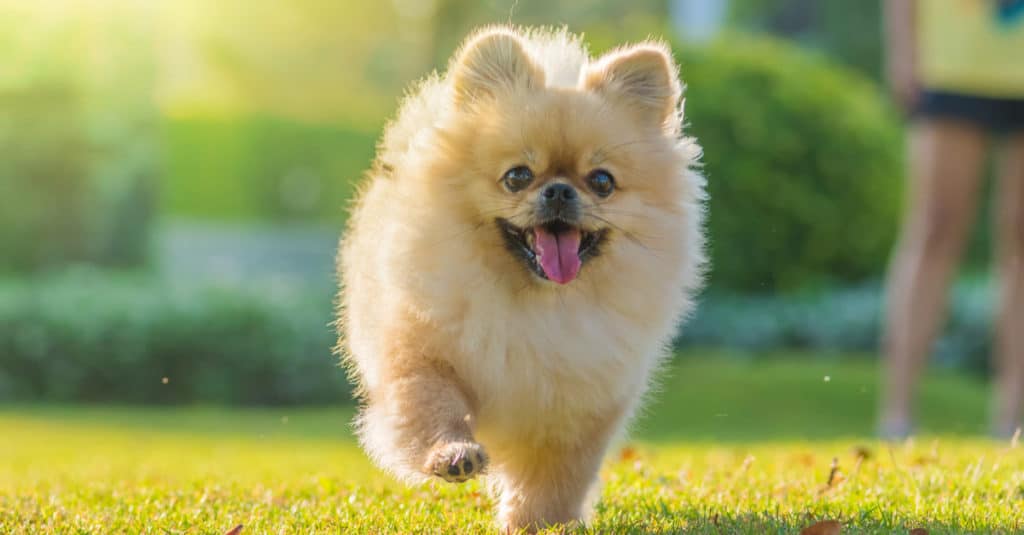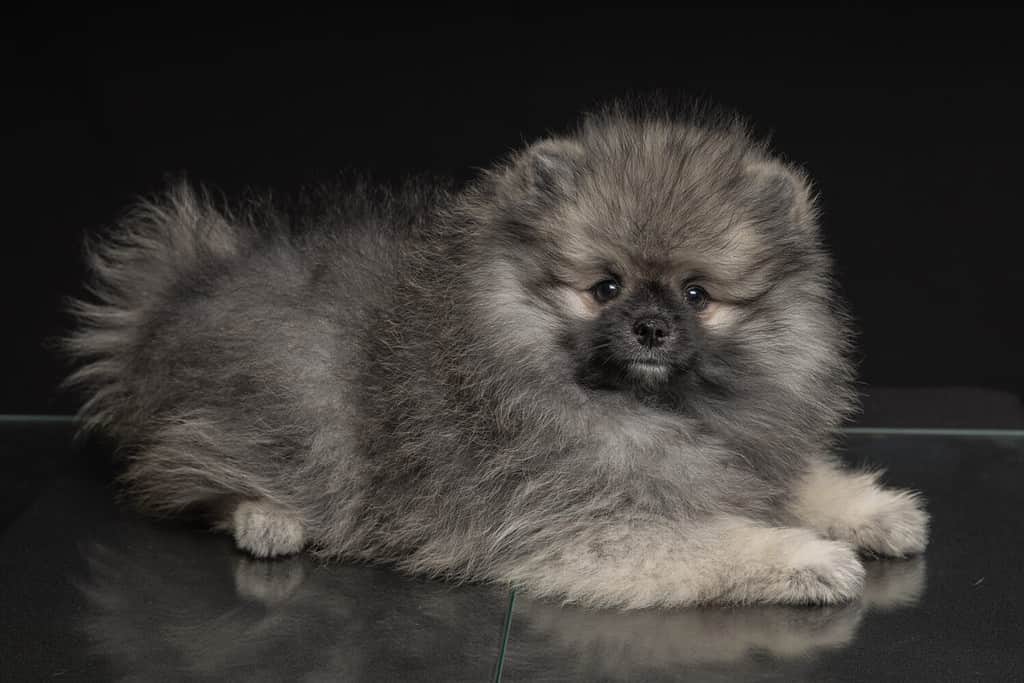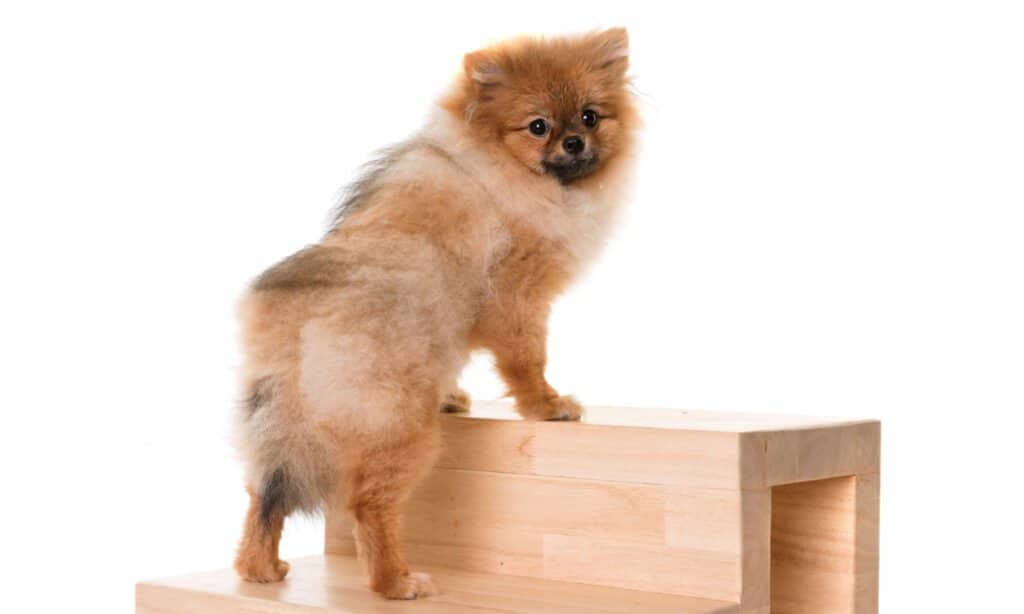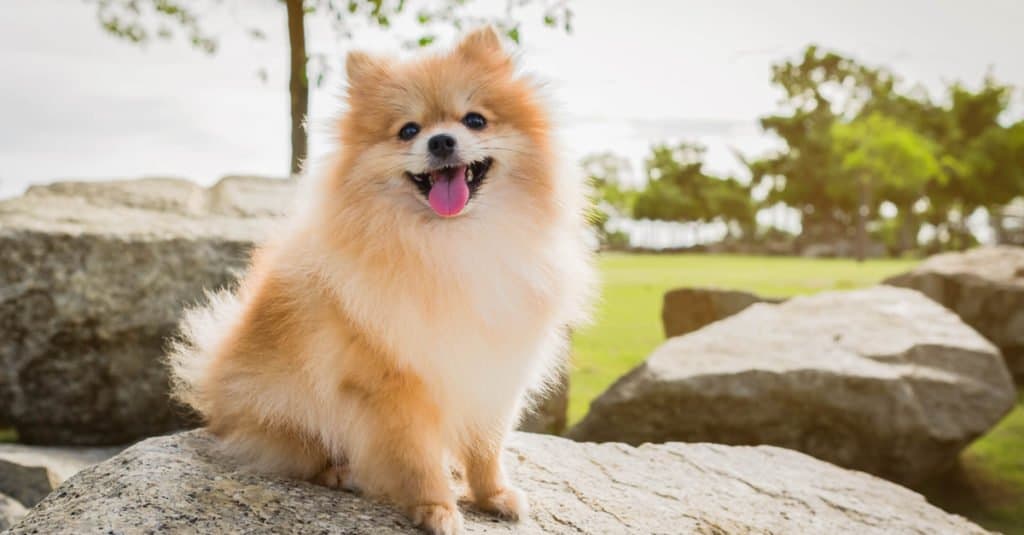Have you just welcomed an adorable Pomeranian puppy into your home? If so, it’s time to learn about all aspects of the journey that lies ahead for your new canine family member! We want the very best for your Pomeranian puppy, so we dive into each aspect of Pomeranian progression below. In this article, we discuss their month-to-month growth, diet tips, grooming tips, and health!
Let’s get started.
Brief History of the Pomeranian Breed

The first Pomeranians weighed close to 30 pounds!
©wirakorn deelert/Shutterstock.com
Did you know that the first Pomeranians weighed close to 30 pounds? The Pomeranian was first created in the province of Pomerania that spanned Poland and Germany. They are descendants of the German spitz dog. The original Pomeranians gained popularity quickly. A Princess in the Pomerania province soon welcomed two of these fluffy pups into her family. When she married an English prince in the late 1700’s, she took her beloved Pomeranian pups with her. The breed was initially only popular in royal circles.
It wasn’t until the late 1800’s, when Queen Victoria began breeding, that Pomeranians became a smaller version of the original. These pups competed in dog shows, and this is how the rest of the world met the Pomeranian.
The Pomeranian was bred smaller and smaller as the years went on, eventually leading to the Pomeranian we know and love today. The Pomeranian was officially recognized by the AKC in 1909. Now, this dog breed is one of the most popular in the U.S.
Pomeranian: Growth and Weight Chart by Age
| Age | Male & Female Weight |
| Birth | 2 – 5 ounces |
| 1 Month | 10 -15 ounces |
| 6 Weeks | 1 – 1.5 pounds |
| 2 Months | 1.4 – 1.8 pounds |
| 3 Months | 1.8 – 2.3 pounds |
| 4 Months | 2.1 – 2.9 pounds |
| 5 Months | 2.5 – 3.3 pounds |
| 6 Months | 3.2 – 4 pounds |
| 7 Months | 3.5 – 4.3 pounds |
| 8 Months | 4 – 4.6 pounds |
| 9 Months | 4.3 – 4.8 pounds |
| 10 Months | 4.5 – 5 pounds |
| 11 Months | 4.8 – 5.6 pounds |
| 12 Months | 5.4 – 7 pounds |
| 2 Years | 5 – 8 pounds |
When Will My Pomeranian Stop Growing & How Big Will They Be When Fully Grown?
The Pomeranian is considered a toy breed dog, so you won’t see any major growth spurts. Most toy breed dogs reach their mature height around nine months of age, and they should reach their mature weight around 10 months of age.
The average Pomeranian can reach 7-12 inches in height at the shoulder. They can weigh anywhere from five to eight pounds when fully grown. Your Pomeranian may fill out around the belly and chest over time, but this will vary based on lifestyle.
We understand if you want a more accurate idea of just how tall your Pomeranian will be at adulthood. Be sure to see your Pomeranian’s parents in person if you need a more accurate representation of eventual size.
When Should My Pomeranian Stop Eating Puppy Food?
Your Pomeranian may not grow as large and as fast as his large breed canine friends. However, he still needs proper nutrition to grow into a healthy adult. The best diet for a Pomeranian puppy contains calcium for bone growth, vitamins and minerals for cognitive development, and more calories per cup than the average adult dog food. A quality puppy food contains each of these things!
Your growing puppy will need to eat a puppy diet until he reaches his adult size. We suggest feeding him puppy food until the age of nine months. Once he reaches nine months of age, you will need to switch over to an adult dog food for small breed dogs. Just be sure to avoid changing his diet abruptly, as this can lead to upset stomach in your furry friend.
When Will My Pomeranian Start Losing Teeth?

Pomeranians begin to lose their puppy teeth around three months of age.
©iStock.com/Tatyana Consaul
Have you found one of your dog’s puppy teeth on the floor? Well, this is completely normal! Puppies lose their baby teeth to make way for their adult teeth, just like humans. However, it’s important to be aware of the specifics around this process.
Your Pomeranian’s puppy teeth will begin to erupt at around three weeks of age. He should have a full mouth of sharp puppy teeth by the time he is six weeks old. These puppy teeth will stick around for about six more weeks, but they will begin to fall out at the 12-week mark. At this point, you may begin to find the occasional puppy tooth around your home.
He will lose his puppy teeth between the ages of three to six months, but this process should come to an end around the seven-month mark. At this point, your little one will have a full set of permanent adult teeth.
When Should I Start Training My Pomeranian?
It’s a common misconception that small dogs do not need training. Just because your Pomeranian is tiny and easier to manage, does not mean that you should pass on basic obedience training.
Pomeranians are generally friendly and kind natured, but they can struggle with biting and excessive barking. Implementing basic obedience from the moment he enters your home can cut back on these bad behaviors, and it can offer him the structure he needs to thrive. Pomeranians also love to please their owners, so mastering cues is something they enjoy.
Pomeranians are smart dogs, so your growing Pomeranian puppy will catch on to obedience training with ease. Puppies eight weeks and older are typically receptive to the training process, so you can dive into their training from this point on.
What Commands Should I Teach My Pomeranian First?
If you are ready to dive into obedience training, then you may be wondering which commands you should start with first. Here are the common cues that we think all dogs should learn:
- Sit
- Stay
- Lay down
- Come
- Drop it
It’s also important to introduce your Pomeranian to new people, pets, and surroundings. Pomeranians struggle with excessive barking and nipping in unfamiliar situations. You can help them feel confident and comfortable in these scenarios. A confident Pomeranian is key. Obedience training and socialization can result in a confident pup.
When Should My Pomeranian Be House Broken?
While Pomeranians often catch on to obedience training fairly quickly, potty training can take a bit longer due to their small bladders and difficulty holding their urine for long periods. Here are a few methods you need to implement if you are diving into the potty-training process!
- Make sure your pup has a set feeding routine that does not change.
- Always take him outside immediately after waking up in the morning.
- Take him outside after any naps or resting periods.
- Take him outside multiple times a day.
You may also need to crate train your Pomeranian or keep him in an enclosed area with potty pads if you have to leave him at home for more than six hours. He may have accidents around your home otherwise.
When implementing the steps we listed above, your Pomeranian should be housebroken within six months of you diving into the potty-training process.
Grooming Tips for Your Pomeranian
Pomeranians come with quite a bit of grooming responsibly. Their coat can easily become tangled and matted, so you will need to be sure to brush them at least four times per week, or more if they are developing tangles.
You may also need to offer them sanitary trims around their behind, as they can develop fecal matts if their fur is too long. We suggest checking their behind a few times a week to search for any evidence of trapped stool.
When To Spay or Neuter?
If you want to prevent reproductive infections and cancers in your beloved pup, then you will need to consider spaying or neutering once he reaches adulthood. Spaying or neutering can also help to cut down on undesirable behaviors like marking or escape attempts, as hormones often drive these behaviors.
Most veterinarians will recommend spaying or neutering your Pomeranian between the ages of nine months to one year. However, you should trust your vet’s guidance on what’s best for your little one.
Common Health Conditions Seen in the Pomeranian
Most Pomeranians will have anywhere from 12 to 16 years at your side, but there are a few health complications you should be on the lookout for throughout their life. Let’s discuss them below!
Collapsing trachea: This occurs when the rings of cartilage in the dog’s trachea begin to weaken over time. This can cause the trachea to collapse on itself due to the laxity of the tracheal rings, making it challenging for the dog to breathe properly. This can drastically impact the Pomeranian’s quality of life, and it can even be life threatening in severe cases.
Patellar luxation: This is a misalignment of the Pomeranian’s knee joint. It causes the kneecap to become unstable, allowing the kneecap to move in and out of place during activity. Not only is this uncomfortable, but it can lead to painful arthritis in the knee joint over time. The most common signs of patellar luxation include limping, skipping when running, leg stiffness, and leg sensitivity.
Hip dysplasia: This is the abnormal formation of the dog’s hip joints. Hip dysplasia will lead to laxity in the hip joints, often causing the hip joint to rub and grind each time your pup moves. Not only is this very painful, but it can cause a breakdown of the hip joint over time. The most common signs of hip dysplasia include limping, joint stiffness, difficulty getting up and down, avoiding stairs, muscle wasting in the back end, and back leg sensitivity.
Allergies: These dogs struggle with allergies, especially skin allergies. They can be allergic to anything, ranging from pollen to fragrances. Common allergy symptoms include red skin, itchy skin, chewing or licking the paws, skin sores, excessive shedding, sneezing, watery eyes, and GI upset.
Pictures of Pomeranians as Puppies

Pomeranian puppies are as cute as can be!
©Fotofrafrnd/Shutterstock.com

You can dive into your Pomeranian’s obedience training at eight weeks old.
©iStock.com/nadisja
Pictures of Pomeranians Around 6 Months

Pomeranians reach their mature size around nine months of age.
©cynoclub/Shutterstock.com
Pictures of Fully Grown Pomeranians

There are over 18 different colors of Pomeranians!
©Eva Sustar/Shutterstock.com

Pomeranians respond well to training that involves plenty of praise and rewards!
©pattarawat/Shutterstock.com
Are you ready to watch your beloved Pomeranian grow up?
The photo featured at the top of this post is © KristinaSh/Shutterstock.com
Ready to discover the top 10 cutest dog breeds in the entire world?
How about the fastest dogs, the largest dogs and those that are -- quite frankly -- just the kindest dogs on the planet? Each day, AZ Animals sends out lists just like this to our thousands of email subscribers. And the best part? It's FREE. Join today by entering your email below.
Thank you for reading! Have some feedback for us? Contact the AZ Animals editorial team.







